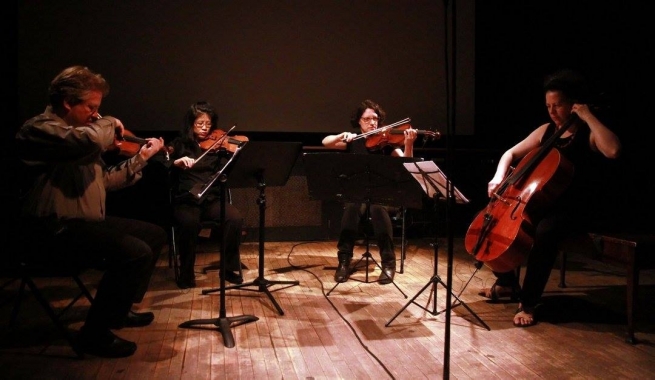
With over 100 events across diverse musical categories, the Suoni per il Popolo Festival encompasses several thriving thematic series. While it is theoretically possible for fans of free improvisation, contemporary classical, noise, or alt-rock to attend a concert almost every evening and remain within their preferred genre, the quality Canadian and international performers entice most attendees to mix it up, scurrying from one venue to another to catch multiple acts in one night. Free jazz has always been a focal point; this year, audiences were treated to a dream-like set from the Anthony Braxton Sextet, which featured two harpists; the blistering solo saxophone of Roscoe Mitchell; and Peter Brötzmann’s duo with pedal-steel guitarist Heather Leigh. While Suoni’s traditional strengths remained intact, it was the unique experiences that left the strongest impressions.
The festival began the same day President Trump announced that the United States was pulling out of the Paris climate agreement. That day, at the vernissage for Still Listening, a planned eighty-fifth-birthday celebration for Pauline Oliveros that turned into a memorial event after Oliveros passed away last fall, eighty-seven scores were on exhibit in the McGill University Marvin Duchow Music Library. In light of the day’s news, one could not miss the irony of celebrating a woman renowned for her environmentally conscious mindset, but what might have been a gloomy affair was lit up by the warmth and brilliance on display. Twenty-seven of these scores were sounded the next evening, starting with Oliveros’ life partner Ione’s reading of “This Day / That Day,” based on quotes from Oliveros. This set the tone for the evening, displaying not only the enormous influence Oliveros had on several generations of composers, but highlighting the deep personal relationships she had forged with so many of them. Most works were performed by Montreal’s Novarumori ensemble, directed that evening by trumpeter Amy Horvey. Recurring themes included drone-based works like Seth Cluett’s “Ether Music,” where musicians search for unison tones; spoken pieces citing Oliveros’ influence, including Stuart Dempster’s “. . . and I don’t know where to start”; and humorous works like Leila Ramagopal Pertl’s “Divine Play,” which has two musicians tossing a ball back and forth. The evening appropriately ended with Stephanie Loveless’ quiet drone titled “Grieving for Pauline.” All scores are archived at <stilllisteningoliveros.com>.


For the Trading Places series, cellist Peggy Lee and guitarist Cole Schmidt, both from Vancouver, were matched with local improvisers for a week of workshops and jam sessions. Participants in a workshop led by Montreal trumpeter Craig Pedersen were able to demonstrate what they had learned by taking part, later that day, in a three-hour jam featuring a roster of rotating musicians. The music mostly tended towards free improvisation of the British variety, although some moments leaned towards free jazz or some mixture of the two. It was interesting to hear the transitions as musicians moved from listening in the audience to performing on stage and back, the onstage cast increasing as the event moved towards its grand finale with everyone on board.
The Quatuor Bozzini performed Marielle Groven’s Song without Wings, but Burning Anyway, which had the strings starting sparsely with drones and trills, gradually building into a crescendo of squeals. Allison Cameron’s Five Postcards for String Quartet consisted of a series of vignettes using different string techniques, with the composer joining the quartet for an improvised ending. That same evening featured the magnificent duo of Lee and vocalist Mary Margaret O’Hara, whose unhinged theatrical presence set a retrofuturistic cabaret vibe, as standards like “Somewhere Over the Rainbow” and “Pennies from Heaven” were inventively contorted. The duo turned into a quartet when joined by Groven on piano and Cameron on banjo and assorted electronics, displaying another side of their virtuosity.
Phill Niblock presented two works for five string quartets, all of whom were in fact the Bozzini, accompanying in live performance four recordings they’d made earlier in the week. Both pieces emphasized long tones that only occasionally changed pitch. Cancellations and interferences from near-unison notes issuing from the multitudes of strings created shimmering waves of sound, revealing a chaotic minisymphony hidden beneath the more stable surface. After an intermission, Niblock presented over one hour of extreme close-up films of flowers, lakes, and forest scenes, the abstract-expressionist nature meshing well with his soundscapes.
The 333 ToutArtBel troupe presented an engaging live rendition of l’Infonie’s first record, from 1969. This was a happening in the ’60s sense of the term, with sixteen musicians and a conductor playing in front of four live-action painters, and a dancer slowly gyrating to the beat. The eight surviving members of l’Infonie, who were in the audience, were touched by this concert performed by young musicians who were not even alive at the time of the original release. As original vocalist Raôul Duguay remarked, l’Infonie’s goal was “to be wise and foolish at the same tim”—a perfect summary of the music’s message.
At the Centre Phi, inventor-composer Ellen Fullman moved up and down the aisle activating her Long String Instrument, creating an otherworldly resonance in the long, thin hall crowded with curious listeners. It is a rare treat to hear what plucking, rubbing, and sliding along twenty-one-metre-long strings sounds like. Imagine the effort required to set up such an instrument, grounded by two three-foot-tall miked wooden bridges, anchored on either side by the several hundred kilograms of sand required to offset the pressure from two sets of eighteen strings, separated by an aisle. Heavy metal clips weighed down by stones were attached to the strings at precisely measured distances. These served as stopping points for this justly tuned instrument, which looked as beautiful as it sounded.
On the avant-pop music front, Horse Lords’ hypnotic guitar and circular-breathed sax riffs meshed into a minimalist pulsing frenzy. At the opposite end of the spectrum, Eric Chenaux’s relaxed banter bookended his set of mutant folk songs. Previously living in Toronto but now based in Paris, Chenaux employed echo, flanger, and nonstop string bending on his guitar, all techniques not normally associated with the genre. Nevertheless, the strange combinations worked their magic, much like the Suoni festival itself.
Photo of Quatuor Bozzini performing at Suoni Per Il Popolo by Pierre Langlois (courtesy of Suoni).


